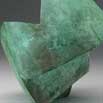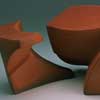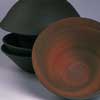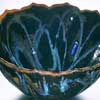
|
|
 |
 |
 |

BRONZE SCULPTURE
The bronze sculpture project started in 2007 when my friend Jay Lindsay,
of Carmel NY, wrote me that he had bought 800 pounds of bronze ingot. I knew
immediately what to do with some of that ingot. As early as 2001 I made some
small maquettes of clay sculptures that would translate readily to larger
bronze forms. I have kept those forms for future reference, and with Jay's
significant help, ten of these forms have been cast in bronze. Some have been
enlarged to a scale of from 15 to 26 inches. Some have been cast in the original
scale of five to eight inches.
So why am I interested in bronze? When I began working in clay sculpture,
the first pieces were glazed and rather shiny. I was then drawn to working
with the dark, porous- appearing, rather dry, wood-fired brick clay. The
bronze surface is somewhere in between, cool and hard, but not reflective.
Bronze carries a feeling of permanence. When I arrive at a form that, to my
eye, appears mature, I have a desire to see it realized in bronze. Bronze
of the material works for my forms.

CLAY SCULPTURE
This body of work has evolved over the last 20 years. Originally it was
all glazed stoneware and intended for flower arranging. Over time it has
become unglazed, and most often made from brick clay. I am inspired by
the work of Chuck Ginnever, Tony Smith, the Constructivists and Futurists,
among others. These pieces are made from extruded parts that are cut
apart, altered and reassembled. Sometimes you can see the original extruded
shape and sometimes not at all. Many pieces work in more than one
position there is usually more than one "right side up."
This method is slow and deliberate. A single piece can take days, a week
or a month and then crack or break in the drying or firing. The results
depend on the vagaries of the firing for color and texture. After weeks or
months of handbuilding the changeover to working on the wheel feels fluid,
quick and quite free. I find that moving back and forth between these
techniques is very rewarding.

BRICK CLAY
Brick clay pots are also functional but are best used for salads and fruit
and are not suitable for use in the oven. They are fired at a moderate
temperature of 2000 to 2100°F in what I call a soft fire method, using no glazes.
The clay is just barely fused and the ash isjust slightly melted. The bowls are
fired upside down over vases or are otherwise protected from direct flame
and ash. I hope to achieve brick reds, ochres, occasionally dark shades of
blue and green with black around the edges. The outside surfaces show
darker blacks with strong fire marks. These pots are placed into the kiln
without decoration and the fire does all the work.
These bowls should be cared for as you would a wooden salad bowl.
Before the first use, wash normally with detergent and a brush or
scrubby. Rinse thoroughly and enjoy the colors which are enhanced
when wet. Dry by allowing the bowl to sit upside down on a drain board.
Do not try to wipe the bowl. After being used as a salad bowl, wash as
above and allow to air dry. A small amount of oil will remain on the
bowl, and will leave a wet look. Over time the interior surface will
become smooth and the color will deepen.
I treat the vases with a fine wax inside and out to make them water
resistant, and to help maintain the "wet look."

STONEWARE
The majority of my work is glazed, functional stoneware. It is inspired
by eight years of study under Japanese teachers from 1963 to 1970, including
two years in Karatsu, Japan. My work is also informed by Korean and
Chinese ceramics. Although born in Minnesota, somewhere west of Lake
Woebegone, I am of English and Scottish descent, so these cultures also
have a strong influence. The forms are accessible, the glazes are mostly
ash based and glossy, the wood fire leaves only modest marks on the pot,
except for those pieces positioned at the front of the kiln chamber. This
work is fired at 2300 to 2500°F.
|
|
 |

|
 |

